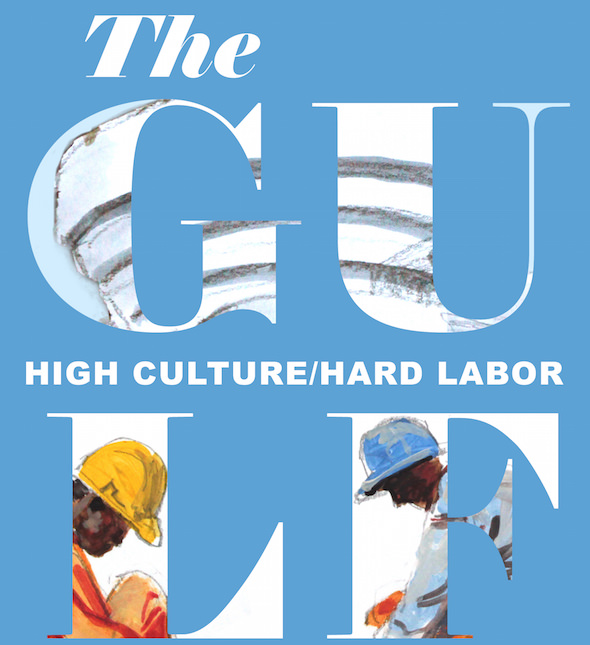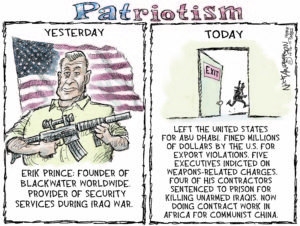‘The Gulf’: Shedding Light on Dark Doings in the United Arab Emirates
A coalition of artists and writers has been instrumental in raising awareness of the mind-boggling exploitation of laborers who support some of the richest people on the planet.
Below is an excerpt of the introductory essay from “The Gulf: High Culture/Hard Labor,” edited by Andrew Ross (for Gulf Labor) (OR Books, 2015). Ross explains the genesis and mission of the Gulf Labor Coalition, a cosmopolitan group of artists and writers fighting to ensure worker protection in the United Arab Emirates. Their works are collected in “The Gulf,” out this fall and now available for pre-order. Here’s a discount code for 10 percent off at checkout (in addition to the 15 percent off for pre-order, making a net 25 percent off the book): GULF10
The roaring wealth of the Persian Gulf states derives from high-yield petroleum reservoirs far beneath the desert sands. But the lustrous towers and grand villas that support the de luxe lives of the region’s elites are not the direct result of slow organic decomposition underground. The gleaming cityscapes of Abu Dhabi, Dubai, Doha, and Bahrain are being assembled, at boomtown speed, from the hard-pressed labor of armies of migrant workers from India, Bangladesh, Pakistan, Nepal, and, increasingly, North and East Africa. Bound to an employer by the kafala sponsorship system, the laborers arrive, heavily indebted from recruitment and transit fees, only to find that their Gulf Dream has been a mirage1 [see footnotes at end of excerpt]. Typically, the sponsoring employer takes their passports, houses them in substandard labor camps, pays them much less than they were promised, and enforces a punishing work regimen under the hot desert sun. Most of them find ways to endure the exploitation, but many fall prey to suicide, or die from overwork or the heat. If they voice their complaints or protest publicly, they are arrested, beaten, and deported.
The Gulf states are hardly alone in their dependence on tragically underpaid and ill-treated migrant workers. Every developed and fast developing country has its own record of shame. But these nations are in a league of their own. The opulent lifestyle of a minority—composed of citizens and corporate expats—is maintained by a vast majority (up to 90 percent in the United Arab Emirates and Qatar) who function as a servant class, with no rights and very little mobility, and whose compliant labor is secured through the fear of abuse and deportation. Their plight is so acute that, in recent years, the push to reform the cruel kafala system (instituted as a temporary guest program in the early 1970s) has become an international cause.2
By the end of 2014, the Gulf Cooperation Council (GCC), which comprises Bahrain, Kuwait, Oman, Qatar, Saudi Arabia, and the United Arab Emirates (UAE), was facing down a flood of overseas pressure to dismantle the kafala system. Spearheaded by Human Rights Watch, more than 90 human rights groups, many from the workers’ countries of origin, signed a call for wide-ranging reforms of labor migration policies. Following allegations by the International Trade Union Confederation of “exploitative practices that may amount to forced labour,” the International Labor Organization (ILO) launched an official investigation of the UAE.3 Amnesty International released a report, titled There is No Freedom Here, on the treatment of political dissenters in the Emirates.4 In response to the soaring death toll among the Nepalese working on Doha’s construction spree, FIFA, the global football federation, was hotly petitioned by its European members to insist on labor reforms as a condition of Qatar’s hosting the 2022 World Cup.5 Investigative journalists from leading media organizations routinely filed front-page stories about the human cost of importing a workforce so vulnerable to abuse.6
Though its name did not always appear alongside those of the NGOs and high-profile advocacy groups, the Gulf Labor Coalition has played a key role in raising awareness of labor exploitation, especially in the UAE. An international network of artists and writers, energetically focused on Abu Dhabi’s development of a new cultural zone on Saadiyat Island, Gulf Labor was able to do and say things that the more official organizations could not. Our creative approach to activism was inspired and innovative, and, in some respects, unique in the field of labor advocacy. More decisive was the position of our artist members as coordinators of cultural value, with some leverage over the politics of constructing museum branches of the Guggenheim and Louvre on Saadiyat.
While human and labor rights groups are denied entry into the UAE, and have only limited access in neighboring Qatar, the strenuous project of nation-building in both countries requires a degree of openness to producers of high culture. Art, after all, has become a status component of the amenity environment demanded by the GCC’s affluent residents and visitors. Museums, galleries, and trade fairs are now obligatory landmarks for the global investor class. As the essential brokers of acquisitional prestige, cultural producers have to be courted, but only if they hold their tongues, and turn a blind eye to the daily suppression of basic rights. Because the constituencies it represents are both sought out and feared, Gulf Labor was probably in the right place at the right time. Over time, our members were regularly consulted by the NGOs, our reporting was cited in the media exposés, and the publicity generated by our actions reached a much wider audience than the communities of conscience who typically respond to reports about human and labor rights violations.
As for the impact on the artworld itself, New York Times art critic Holland Cotter, in his roundup of 2014’s notable events, singled out Gulf Labor’s campaign and the work of the Global Ultra Luxury Faction (a direct action spinoff). “The groups’ action,” he summarized, “has been carefully organized, effectively executed and persistent, as any protest that’s going to work must be.”7
* * *
The wealth and de facto power of Emirati elites is immense, and the board members of NYU and the Guggenheim are equally rich and influential. How did Gulf Labor persevere in the face of such formidable adversaries, and why has it achieved some measure of success? Campaign strategy was an important component. The tactics of the coalition have been diverse and well-considered, and they are discussed in more detail in other chapters of this volume. But there were also some large-scale factors and conditions operating in favor of our tactics.
Over the course of the last decade, Western high-culture institutions have been following in the path of corporations that went offshore 20 years before. The underlying motive—to beef up their balance sheet—is more or less the same, but the rationale for operating overseas has to be presented as more than a monetary undertaking. More often than not, these initiatives are couched in rhetoric about spreading the virtues of Western-style liberal arts, which at times can sound little different from the 19th-century credo of the mission civilisatrice. When quizzed about the appearance of being in bed with authoritarian rulers—the preferred destinations of many of these institutions are China and the Persian Gulf states—administrators will insist that their presence allows them to “lead by example.” Moreover, institutions with reputations as “leaders” do not expect to have their decisions challenged from their rank and file employees. Yale University administrators, for example, were surprised to field criticism from faculty members following Yale’s agreement to a joint venture with the National University of Singapore; the faculty cited Singapore’s “history of lack of respect for civil and political rights.” And NYU’s John Sexton has faced down a barrage of criticism for his expansionist efforts, some of which fed into faculty votes of no confidence in his presidency.
But the rhetoric of the civilizing West also creates an opening to challenge the basic terms of debt peonage that underwrite workers’ contracts in the UAE. Prominent, PR-sensitive outfits like NYU, the Guggenheim, the Louvre, and the British Museum (chief consultants to Saadiyat’s Zayed National Museum) are susceptible to the tarnishing of their brand. The elevated cultural standing of their names and their institutional missions is wholly incompatible with the taint of labor and human rights abuse—they cannot afford to be associated with such tawdriness.
Fifteen years ago, anti-sweatshop activists used the same tactic of shaming global brands like Nike and the Gap in order to publicize labor abuses in the offshore factories of the apparel industry. Just as the garment brands tried to deflect responsibility further down the subcontracting chain, so too have these high-profile educational and cultural institutions. Across the board, their alibi boils down to a simple claim: We have little control over what the subcontractors do or pay. It took many years of campaigning and legal pressure to force the apparel brands to accept some liability for abuses that occur all the way down the chain. Unlike garment factories, however, which can be moved overnight to more obscure locations, the museums and the NYU campus are there to stay, offering long-term leverage to activists. And while apparel manufacturers have little internal accountability to their users, universities have obligations to their faculty and students, and museums are answerable to public ethics upheld by the more conscientious factions of the artworld.
Nor are these cultural bodies quite like corporations, bent on repatriating their offshore profits as quickly as possible. There’s no question that their fiscal managers and boards are all too happy to take the loot. To bring the Louvre to the Gulf, Abu Dhabi authorities agreed to a 1.3 billion USD package, including 520 million USD for use of the name alone. The bankrolling of NYU Abu Dhabi is estimated to be in the billions. But how do administrators combat the perception of selling out? How do they make the arrangement palatable to the museums’ constituency, and to the faculty and students of the university, all of whom may find any mention of hard cash to be distasteful? Delivering a high-caliber cultural or educational product is different from manufacturing a shoe that will pass some minimal quality standard. Maintaining the good will of all the participants in a cultural process is a challenge at the best of times, and it is even more arduous if their resident cynicism about monetizing also has to be overcome. Ultimately, no matter how much time and money is invested in these efforts, they can easily run aground when some endemically corrupt association surfaces.
Footnotes
1. The kafala system, employed in all the Gulf Cooperation Council (GCC) states, requires all migrant laborers to have an in-country sponsor who oversees their visa and legal status. 2. Priyanka Motaparthy, “Understanding Kafala: An Archaic Law at Cross Purposes with Modern Development,” Migrant-rights.org (March 11, 2015), http://tinyurl.com/lqjytvf 3. David Batty, “UN Investigates Claims of Gulf State Abuse of Migrant Workers,” Guardian (November 29, 2015), http://tinyurl.com/kmfrnut 4. Amnesty International, “ ‘There is No Freedom Here’: Silencing Dissent in the United Arab Emirates,” (November 18, 2014), http://tinyurl.com/nz7xkhp 5. Owen Gibson and Pete Pattisson, “Death Toll Among Qatar’s 2022 World Cup Workers Revealed,” Guardian (December 23, 2014), http://tinyurl.com/o3bb489 6. Glenn Carrick and David Batty, “In Abu Dhabi, They Call It Happiness Island,” Guardian (December 21, 2013). 7. Holland Cotter, “Holland Cotter’s Notable Art Events of 2014,” New York Times (December 11, 2014).
Your support matters…Independent journalism is under threat and overshadowed by heavily funded mainstream media.
You can help level the playing field. Become a member.
Your tax-deductible contribution keeps us digging beneath the headlines to give you thought-provoking, investigative reporting and analysis that unearths what's really happening- without compromise.
Give today to support our courageous, independent journalists.



You need to be a supporter to comment.
There are currently no responses to this article.
Be the first to respond.